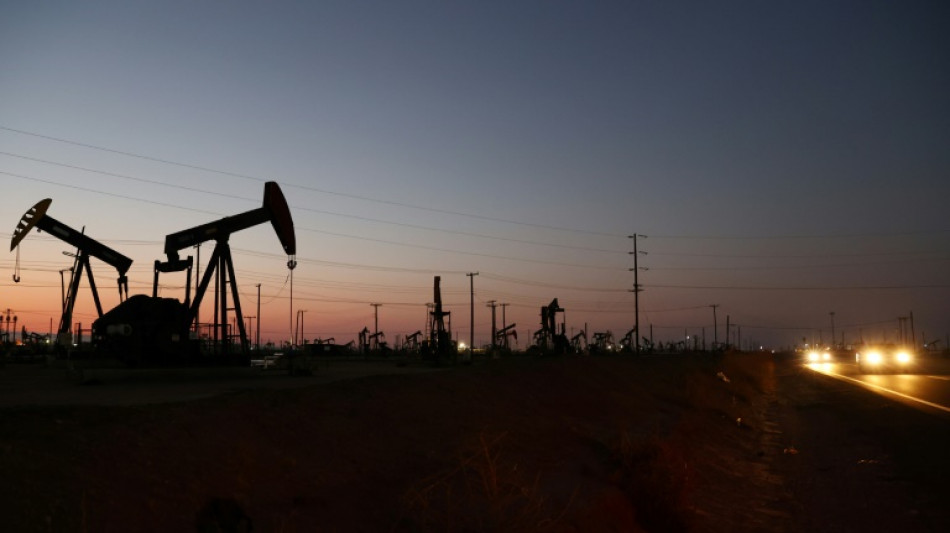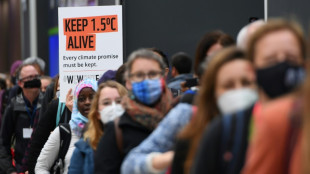
-
 Philippine House votes to impeach VP Sara Duterte
Philippine House votes to impeach VP Sara Duterte
-
Tokyo police bust alleged prostitution ring targeting tourists

-
 Baltics to cut Soviet-era ties to Russian power grid
Baltics to cut Soviet-era ties to Russian power grid
-
Iraq's famed 'hunchback' of Mosul rebuilt brick by brick

-
 Stock markets stutter as traders weigh China-US trade flare-up
Stock markets stutter as traders weigh China-US trade flare-up
-
Hamas rejects Trump proposal to take over Gaza, move Palestinians

-
 MotoGP champion Martin taken to hospital after Malaysia crash
MotoGP champion Martin taken to hospital after Malaysia crash
-
YouTubers causing monkeys to attack tourists at Cambodia's Angkor Wat

-
 Sweden reels from worst mass shooting in its history
Sweden reels from worst mass shooting in its history
-
India's Modi takes ritual dip at Hindu mega-festival

-
 Nissan shares fall as reports say Honda merger talks off
Nissan shares fall as reports say Honda merger talks off
-
US Postal Service says suspending parcels from China

-
 Toyota announces Lexus EV plant in Shanghai
Toyota announces Lexus EV plant in Shanghai
-
Santander reports record profit for third straight year

-
 No new clothes: S. Korean climate activist targets hyperconsumption
No new clothes: S. Korean climate activist targets hyperconsumption
-
Cummins 'hugely unlikely' for Australia's Champions Trophy bid

-
 Nissan shares plunge as report says Honda merger talks off
Nissan shares plunge as report says Honda merger talks off
-
China holds out hope last-minute deal can avert US trade war

-
 LeBron relishing 'special' Doncic double act
LeBron relishing 'special' Doncic double act
-
Tatum shines as Celtics down Cavs, Lakers thrash Clippers

-
 Myanmar junta bid to sell Suu Kyi mansion flops for third time
Myanmar junta bid to sell Suu Kyi mansion flops for third time
-
Australia bans DeepSeek AI program on government devices

-
 Olympics on horizon as China hosts Asian Winter Games
Olympics on horizon as China hosts Asian Winter Games
-
Tatum, White shine as Celtics down Cavs

-
 Google pledge against using AI for weapons vanishes
Google pledge against using AI for weapons vanishes
-
African football has the platform for historic World Cup success

-
 France prop Gros happy to go 'under radar' for Dupont's benefit
France prop Gros happy to go 'under radar' for Dupont's benefit
-
Bove's future uncertain after heart attack horror as Fiorentina finish Inter clash

-
 Race against time to complete contested Milan-Cortina bobsleigh track
Race against time to complete contested Milan-Cortina bobsleigh track
-
Speed queen Goggia pursuing Olympic dreams with 2026 Winter Games on horizon

-
 Asian markets stutter as traders weigh China-US trade flare-up
Asian markets stutter as traders weigh China-US trade flare-up
-
French PM set to survive no confidence vote

-
 Trump says US will take over Gaza, create 'Riviera of the Middle East'
Trump says US will take over Gaza, create 'Riviera of the Middle East'
-
Google shares slide on spending plans despite sales jump

-
 Honda shares jump on reports it wants Nissan as subsidiary
Honda shares jump on reports it wants Nissan as subsidiary
-
Trump says US will 'take over' Gaza as he welcomes Netanyahu

-
 Netflix drops 'Emilia Perez' star Oscar bid over offensive posts: reports
Netflix drops 'Emilia Perez' star Oscar bid over offensive posts: reports
-
Sirianni embraces emotions ahead of Chiefs rematch

-
 Top climate scientist declares 2C climate goal 'dead'
Top climate scientist declares 2C climate goal 'dead'
-
US Treasury says Musk team has 'read-only' access to payments data

-
 Leaders 'should respect' wishes of Palestinians to stay in Gaza: Palestinian UN envoy
Leaders 'should respect' wishes of Palestinians to stay in Gaza: Palestinian UN envoy
-
Paris Saint-Germain, Brest, Dunkerque advance to French Cup last eight

-
 Simeone brace helps Atletico thrash Getafe, reach Copa del Rey semis
Simeone brace helps Atletico thrash Getafe, reach Copa del Rey semis
-
Trump hosts Netanyahu for pivotal Gaza ceasefire talks

-
 Atletico thrash Getafe to reach Copa del Rey semis
Atletico thrash Getafe to reach Copa del Rey semis
-
Stocks recover but tariff uncertainty lingers over market

-
 Shiffrin to sit out world team combined, dashing Vonn hopes
Shiffrin to sit out world team combined, dashing Vonn hopes
-
Mahomes avoids 'G.O.A.T' talk as history beckons

-
 Undav sends Stuttgart into German Cup final four
Undav sends Stuttgart into German Cup final four
-
Alcaraz battles through in first match since Australian Open


Increase in atmospheric methane set new record in 2021: US
For the second year running, US scientists observed record increases in the atmospheric concentration of the potent greenhouse gas methane, the National Oceanic and Atmospheric Administration (NOAA) said Thursday.
Methane, the second biggest contributor to global warming after carbon dioxide, is generated by the production, transport and use of fossil fuels, but also from the decay of organic matter in wetlands, and as a byproduct of ruminant digestion in agriculture.
At last year's COP26 Climate Change Conference in Glasgow, participants agreed to a Global Methane Pledge to reduce methane emissions by 30 percent by 2030 -- but notable emitters including China, Russia, Iran and India have not signed on.
"Our data show that global emissions continue to move in the wrong direction at a rapid pace," said NOAA administrator Rick Spinrad in a statement.
The annual increase in atmospheric methane during 2021 was 17 parts per billion (ppb), the largest rise recorded since systematic measurements began in 1983, said NOAA.
Across 2021, atmospheric methane levels averaged 1,895.7 ppb, around 162 percent greater than pre-industrial levels.
"We can no longer afford to delay urgent and effective action needed to address the cause of the problem -- greenhouse gas pollution," Spinrad warned.
It's estimated about 30 percent of methane comes from fossil fuel production -- making it a clear target for lessening the impacts of the climate crisis in the short term.
Meanwhile, carbon dioxide levels continued to increase at historically high rates.
NOAA found that the global surface average for carbon dioxide during 2021 was 414.7 parts per million (ppm), which is an increase of 2.66 ppm over the 2020 average.
Atmospheric levels of carbon dioxide are now comparable to where they were 4.3 million years ago, during the mid-Pliocene epoch.
At that time, the sea level was about 75 feet (23 meters) higher than today, the average temperature was 7 degrees Fahrenheit (4C) higher than pre-industrial times, and large forests occupied areas of the Arctic.
Methane is far less abundant but around 25 times more potent than carbon dioxide at trapping heat in the atmosphere.
The "atmospheric residence time" of methane is approximately nine years, compared to thousands of years for carbon dioxide -- therefore controlling methane is critical to influencing the rate of climate change in the near future.
Methane also contributes to the formation of ozone at the ground level, which in turn is the main ingredient in smog and has harmful effects on the environment and people's health.
Previous NOAA methane research indicated that biological sources of methane -- such as from wetlands -- are the main driver of increasing methane post-2006.
This is worrying because it may signal a feedback loop caused by more rain over tropical wetlands, which in turn generates yet more methane -- a cycle that would become largely outside of human control.
T.Bondarenko--BTB




